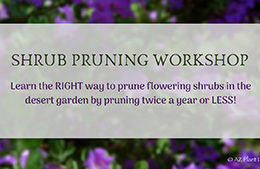My Fall Garden
A few days ago, I received an unexpected gift. This gift was a morning where I had no appointments, I didn’t have to babysit my granddaughter, the kids were in school and I was caught up with all of my garden writing.
So, what should I do with this gift of time?
I spent it in my garden, taking pictures of the plants that make me happy right now.
I’d love to share my favorites with you if you have a few minutes of time…
Pink Trumpet Vine (Podranea ricasoliana)
One of my favorite plants growing in my gardens is Pink Trumpet Vine. It stands at the corner of one of my vegetable gardens. It is in full bloom right now as you can see. Gorgeous pink flowers appear in spring and fall.
It can grow as a vine, with support, or as an open, sprawling shrub, which is how I like to grow it.
Pink Trumpet Vine does suffer frost damage and has even been killed to the ground in winter, but quickly grows back. It is hardy to zone 7.
Cascalote (Caesalpinia cacalaco)
Bright-yellow flower spikes cover my Cascalote tree in fall. I love this small tree for so many reasons.
It is slow-growing, so there is not a lot of pruning required. I love the round leaves that stay on the tree all year unless we get a cold spell of temps in the low 20’s.
Best of all, are the yellow flowers that appear in fall when most plants are beginning to slow down.
*Cascalote are very thorny and I personally think that the thorns are very cool-looking as long as you don’t get pricked. There is a new variety called ‘Smoothie’ that is thornless.
Queen’s Wreath Vine (Antigonon leptopus)
Despite my best attempts, my Queen’s Wreath Vine insists on growing up the trunk of my Cascalote tree instead of up on the nearby garden wall.
But, I love this vine no matter where it chooses to grow. It has heart-shaped leaves and stunning pink flowers that appear in summer and fall.
This is a tough vine that can handle reflected heat and does not need support to grow upward. In winter, it will die back to the ground, but grows back in spring. Hardy to 20 degrees F, or zone 9 gardens.
Gold Lantana
I know that Lantana can seem like a rather boring plant to some – but I wouldn’t write it off, if I where you.
Lantana is not fussy and it’s hard to find a plant that will bloom more throughout the warm months of the year. I have it growing up along my front entry and I really like how it looks.
Maintenance is simple – prune back to 6 inches once the danger of frost is over (early March in my garden), removing all frost damage. Lightly prune back by 1/2 in August and that is all you need.
Lantana are frost-tender and hardy to 10 degrees (zone 7).
My Fall Garden
My side garden is filled with another vegetable garden, apple and peach trees, blackberry shrubs and herbs.
Because I do not like looking out at bare walls, I have Pink Trumpet Vine, Arizona Yellow Bells (Tecoma stans stans), ‘Summertime Blue’ (Eremophila x ‘Summertime Blue’) and Pink Emu Bush (Eremophila laanii) planted along the wall.
These large shrubs are pruned once a year and that is all they need because I have given them enough room to stretch out.
While these flowering shrubs make my bare wall disappear, they also benefit my edible garden in the side yard. First, they help absorb the heat that the walls re-radiate out, keeping temperatures down. Secondly, they also attract pollinators which pollinate my vegetables, fruit trees and blackberries.
Hummingbirds and other feathered visitors like to take shelter in their branches and I get to watch from my kitchen window.
My Fall Garden
In this garden, the vegetables are still rather small. But there is a collection of broccoli, cauliflower, radishes, carrots and Swiss chard.
An newly-planted artichoke is growing nicely next to some young carrot seedlings. This vegetable doesn’t just produce delicious artichokes – they are also quite ornamental.
Just one month after sowing radish seeds, I am harvesting radishes already.
In the corner of my vegetable garden is a Mexican Milkweed (Asclepias curassavica) that I grew from seed.
They are irresistible to butterflies and bees like them too 🙂
I have a rusty watering can that I just love. Every fall I fill it with flowering annuals that will last through spring.
I poked drainage holes in the bottom of the can and put a drip emitter next to the flowers. Once temperatures heat up into the 90’s, it gets too hot for the roots to survive in the pot, so it sits empty during the summer. But even empty, it adds a touch of whimsy to my garden.
In front of my vegetable garden sits my herb container garden. Chives, parsley, sage and thyme are growing nicely. I like to throw in some petunias for additional color.
This young peach tree was planted back in January and is doing very well.
That little plant next to it is a volunteer basil plant. It will die once our first frost appears, so I will harvest it soon.
In front of my other edible gardens sit three brightly-colored pots filled with an assortment of flowers and edible plants.
This one is filled with a jalapeño pepper plant, garlic, ornamental kale and cabbage, bacopa, petunias, violas and red nasturtiums.
Along the back is a small trellis that has sugar snap peas growing on it. They are just beginning to flower.
This is my daughter, Ruthie’s, vegetable garden. She has leaf lettuce, strawberries, carrots and garlic growing in her garden.
This is my youngest daughter, Gracie’s, garden which has celery, broccoli, sugar snap peas, carrots, malabar spinach and radishes growing in it.
*One of my fondest childhood memories was of my dad giving me a raised garden in the backyard of our Southern California home. I was allowed to grow whatever I wanted, which was usually vegetables, violas and cosmos.
Thank you for taking a few minutes out of your day, allowing me to share my favorites in my fall garden.
What is growing in your garden right now?








What’s Happening In My Fall Garden…
AZ Plant LadyMy Fall Garden
A few days ago, I received an unexpected gift. This gift was a morning where I had no appointments, I didn’t have to babysit my granddaughter, the kids were in school and I was caught up with all of my garden writing.
So, what should I do with this gift of time?
I spent it in my garden, taking pictures of the plants that make me happy right now.
I’d love to share my favorites with you if you have a few minutes of time…
Pink Trumpet Vine (Podranea ricasoliana)
One of my favorite plants growing in my gardens is Pink Trumpet Vine. It stands at the corner of one of my vegetable gardens. It is in full bloom right now as you can see. Gorgeous pink flowers appear in spring and fall.
It can grow as a vine, with support, or as an open, sprawling shrub, which is how I like to grow it.
Pink Trumpet Vine does suffer frost damage and has even been killed to the ground in winter, but quickly grows back. It is hardy to zone 7.
Cascalote (Caesalpinia cacalaco)
Bright-yellow flower spikes cover my Cascalote tree in fall. I love this small tree for so many reasons.
It is slow-growing, so there is not a lot of pruning required. I love the round leaves that stay on the tree all year unless we get a cold spell of temps in the low 20’s.
Best of all, are the yellow flowers that appear in fall when most plants are beginning to slow down.
*Cascalote are very thorny and I personally think that the thorns are very cool-looking as long as you don’t get pricked. There is a new variety called ‘Smoothie’ that is thornless.
Queen’s Wreath Vine (Antigonon leptopus)
Despite my best attempts, my Queen’s Wreath Vine insists on growing up the trunk of my Cascalote tree instead of up on the nearby garden wall.
But, I love this vine no matter where it chooses to grow. It has heart-shaped leaves and stunning pink flowers that appear in summer and fall.
This is a tough vine that can handle reflected heat and does not need support to grow upward. In winter, it will die back to the ground, but grows back in spring. Hardy to 20 degrees F, or zone 9 gardens.
Gold Lantana
I know that Lantana can seem like a rather boring plant to some – but I wouldn’t write it off, if I where you.
Lantana is not fussy and it’s hard to find a plant that will bloom more throughout the warm months of the year. I have it growing up along my front entry and I really like how it looks.
Maintenance is simple – prune back to 6 inches once the danger of frost is over (early March in my garden), removing all frost damage. Lightly prune back by 1/2 in August and that is all you need.
Lantana are frost-tender and hardy to 10 degrees (zone 7).
My Fall Garden
My side garden is filled with another vegetable garden, apple and peach trees, blackberry shrubs and herbs.
Because I do not like looking out at bare walls, I have Pink Trumpet Vine, Arizona Yellow Bells (Tecoma stans stans), ‘Summertime Blue’ (Eremophila x ‘Summertime Blue’) and Pink Emu Bush (Eremophila laanii) planted along the wall.
These large shrubs are pruned once a year and that is all they need because I have given them enough room to stretch out.
While these flowering shrubs make my bare wall disappear, they also benefit my edible garden in the side yard. First, they help absorb the heat that the walls re-radiate out, keeping temperatures down. Secondly, they also attract pollinators which pollinate my vegetables, fruit trees and blackberries.
Hummingbirds and other feathered visitors like to take shelter in their branches and I get to watch from my kitchen window.
My Fall Garden
In this garden, the vegetables are still rather small. But there is a collection of broccoli, cauliflower, radishes, carrots and Swiss chard.
An newly-planted artichoke is growing nicely next to some young carrot seedlings. This vegetable doesn’t just produce delicious artichokes – they are also quite ornamental.
Just one month after sowing radish seeds, I am harvesting radishes already.
In the corner of my vegetable garden is a Mexican Milkweed (Asclepias curassavica) that I grew from seed.
They are irresistible to butterflies and bees like them too 🙂
I have a rusty watering can that I just love. Every fall I fill it with flowering annuals that will last through spring.
I poked drainage holes in the bottom of the can and put a drip emitter next to the flowers. Once temperatures heat up into the 90’s, it gets too hot for the roots to survive in the pot, so it sits empty during the summer. But even empty, it adds a touch of whimsy to my garden.
In front of my vegetable garden sits my herb container garden. Chives, parsley, sage and thyme are growing nicely. I like to throw in some petunias for additional color.
This young peach tree was planted back in January and is doing very well.
That little plant next to it is a volunteer basil plant. It will die once our first frost appears, so I will harvest it soon.
In front of my other edible gardens sit three brightly-colored pots filled with an assortment of flowers and edible plants.
This one is filled with a jalapeño pepper plant, garlic, ornamental kale and cabbage, bacopa, petunias, violas and red nasturtiums.
Along the back is a small trellis that has sugar snap peas growing on it. They are just beginning to flower.
This is my daughter, Ruthie’s, vegetable garden. She has leaf lettuce, strawberries, carrots and garlic growing in her garden.
This is my youngest daughter, Gracie’s, garden which has celery, broccoli, sugar snap peas, carrots, malabar spinach and radishes growing in it.
*One of my fondest childhood memories was of my dad giving me a raised garden in the backyard of our Southern California home. I was allowed to grow whatever I wanted, which was usually vegetables, violas and cosmos.
Thank you for taking a few minutes out of your day, allowing me to share my favorites in my fall garden.
What is growing in your garden right now?
What Is Wrong With This Citrus Tree: The Answer
Citrus, Southwest gardenYesterday, I showed you a photo of a citrus tree that I came upon during a landscape consultation.
I mentioned that there was more then one problem affecting this tree. There are actually two large problems and one small problem.
Problem #1: Look at the area near the trunk. Notice a little green shoot coming up from a small citrus root?
This innocent-looking little sucker can cause a lot of problems if allowed to grow. The reason for this is that citrus trees are grafted onto a vigorous rootstock.
Basically, the top of a citrus tree and the roots come from different plants. Citrus trees we enjoy in our landscape don’t have a particularly strong root system. So, they are grafted onto a thorny, citrus tree that has vigorous roots and sour fruit.
Occasionally, small suckers from the thorny, citrus tree start to grow up from the roots or the base of the trunk below the bud union. The bud union is a bulge around the lower part of the tree, about a foot above the ground. Any suckers that originate from below the bud union should be removed, because if allowed to grow – the thorny citrus tree will grow and take over.
Now, back to our original picture for our second problem…
Problem #2: Look closely at the soil and you can see signs of shallow irrigation. How can you tell? Look at the small citrus roots criss crossing out from the tree. In a properly watered citrus tree, you shouldn’t see the roots at all.
This indicates that when the tree is irrigated, that the water is not turned on long enough to penetrate to the recommended 3 ft. depth.
When I pointed this out to the homeowner, she indicated that if the water is turned for too long, that it runs out from the basin.
There are two solutions for this problem.
– Elevate the sides of the basin to at least 6 inches high and allow to fill with water. Next, check to see how deeply you have watered by taking a long, narrow stick or piece of rebar and push it into the wet soil. It should go down fairly easily to the point where the water permeates. Pull it back out and you will get a good idea of how much more or less water you will need.
– If after trying the first solution and you still haven’t hit the recommended 3 ft. depth, then try this trick – water in the morning, filling up the basin. Allow the water to sink and fill the basin again later in the day. This should help you achieve the right depth.
The smaller problem is really nothing to be overly concerned about…
If you look closely, some of the leaves have ragged edges and holes. The damage is caused by the Orange Dog Caterpillar. This caterpillar appears in the summer months and resemble ‘bird poop’ which makes them hard to spot.
These caterpillars will turn into the beautiful Giant Swallowtail butterfly. Mature citrus trees can usually handle the damage from the caterpillars, so in most cases, the best thing to do is nothing.
For additional resources for raising citrus in the Valley of the Sun and other areas throughout the Southwest, check out this helpful link.
Do you have citrus trees in your landscape? Which kinds?
c
Arizona, California, Citrussomething wrong with citrus tree
Last week, I came upon this citrus tree while I was doing a consultation.
At first, there was one problem that I noticed right away. As I peered closer, I saw that there was another problem affecting this tree.
The tree was well-fertilized and I could see no sign of nutrient deficiencies.
Can you tell what is wrong with this tree?
Leave your guesses below in the comment section and I will reveal the answer tomorrow 🙂
*You may be wondering why you should care about the problems of this particular citrus tree. Well, if you have citrus growing in your garden, you may have the same problem(s) and not even know it.
My hope is to help others identify and correct problems with their plants that they may not be aware of until it is too late.
Coming Off Of A Sugar High…
az plant lady familyI love Halloween…
Every year, each household in our family takes turns hosting different holidays.
Easter and Christmas are spent on the family farm with my youngest sister, her family and my mother.
Fourth of July and Thanksgiving are spend at my other sister’s house.
But, Halloween is all mine…
We don’t do scary Halloween themes. The young kids in the family wouldn’t appreciate it and I must admit that I don’t like scary costume or movies.
What I do like to focus on is making family-friendly decorations and making desserts.
Each year, I like to add to my homemade Halloween decorations. Last year, I made paper-mache pumpkins.
This time I made witches hats using paper plates and party hats. Simply glue them together and spray with black spray paint. I added some black lace around the brim. I am pretty happy with how they turned out.
This year I made homemade marshmallow pops, dipped in candy melts and sprinkles.
I also made Halloween sugar cookies.
The table runner is made of butcher paper with Halloween stamps – I like simple.
Because Halloween is a night for eating lots of sugar, I always ask my mother to bring a healthy pot of soup for us all to share before heading out to trick-or treat.
One of the reasons that I enjoy Halloween so much is the excitement of the little kids as they dress up and get ready to head out. They don’t want to bother with eating any dinner 😉
Here is my granddaughter, Lily, in her Tinker Bell costume. Isn’t she cute? My daughter made her costume 🙂
My daughter, Gracie, went as a medieval queen and my son, Kai, was a zombie like many boys his age this year.
My youngest sister and her family came ready to trick-or-treat.
My mother and I stayed by the fire pit in the front driveway and handed out candy.
My brother brought over my 3-year-old twin nephews who dressed up as sharks.
Lily could hardly wait to get started.
We spent much of the evening keeping warm by the fire while greeting a LOT of trick-or-treaters.
The best part of Halloween is seeing what types of candy you have received.
Lily kept playing with this lollipop without taking off the paper. I really need to teach her about focusing on the chocolate candy bars 😉
We had a fun evening, but it was time to get the kids to bed.
And take down the Halloween decorations…
How did you spend your Halloween?
‘Scary’ Pruning Practices
AgaveIn honor of Halloween, I thought that I would do a ‘scary’ post for all of you.
Now, this post isn’t filled with ghouls, witches, skeletons or zombies. But that doesn’t make it any less scary.
Over the years, I have photographed examples of truly horrific pruning, which are quite scary 😉
WARNING: The following images are not for the faint of heart…
These used to be Jacaranda trees. I say “used to” because they died because of this severe and unnecessary pruning.
This is a photo of a Red Yucca (Hesperaloe parviflora) that was pruned the wrong way.
Unfortunately, this was a landscape that I was in charge of 14 years ago next to the clubhouse on a golf course.
My well-intentioned crew member, thought he was doing me a favor by pruning them for me. He was so proud of the work he had done, that he came into my office and asked me to come outside and see his handiwork.
I must say, that it was hard to criticize him because he was so proud of his work. Needless to say, I transferred him to doing more clean-up and less pruning around the golf course.
A few months later, he returned to his small town in Mexico where he became mayor 🙂
*This is what Red Yucca are supposed to look like when in flower…
As you can see, you don’t cut the grass-like, succulent foliage below – ever. The flowers can be pruned to the base when they die. If the base clump become to wide, then divide the base much like you would perennials.
This photo was taken of another landscape area about 12 years ago that I was in charge of by another golf course. I made sure that the crew did not prune it 😉
Last month, I was in the historic district of downtown Phoenix returning from a landscape consultation when I drove by these very sad California Fan Palms.
While fall is the time to prune back – this is NOT the way to do it. Too much was removed. For guidelines on how to prune palm trees, click here.
This was a beautiful Palo Brea tree. Unfortunately, it was ‘topped’ in order for the homeowner to preserve their view of the mountains.
‘Topping’ trees is very bad for trees. It leaves the upper branches open to sunburn, which is often followed by insect infestations or disease.
In fact, topping trees causes the tree to grow faster, to replace the lost foliage, which leads to an increased need for pruning. The branches that appear after ‘topping’ have a very weak attachment, which makes the new branches a hazard because they are in danger of breaking off.
**If a tree is blocking a view that is important to you – then remove the tree instead of subjecting it to torturing it with this type of pruning.
Here is another example of ‘topping’. This parking lot in Scottsdale, has trees like this.
Believe it or not, this ‘topped’ tree is a Willow Acacia (Acacia salicina).
This is what it should look like…
Hard to believe that they are the same type of tree, isn’t it?
I don’t think that I have ever seen an agave pruned so badly before.
The only time you need to prune an agave is to remove the bottom leaves, once they die.
I think that this agave would have looked much nicer if they had left it alone, like the one below…
It would also be much healthier and less likely to be susceptible to insect attack.
Believe it or not, these are citrus trees.
I could hardly believe my eyes when I drove by and saw what had happened to these trees.
You may be thinking that maybe they suffered from severe frost damage and had to be cut back. But, I assure you, this wasn’t the case. I worked just down the road from this house and there was no reason for these trees to be pruned this severely.
Ideally, citrus trees are pruned in March, concentrating on removing dead branches and suckers.
In fact, did you know that the lower branches produce more fruit that tastes sweeter than that on the higher branches? That is why you see citrus growers letting the lower branches of their trees grow instead of pruning them up into tree shapes.
**Just don’t let any branches (suckers) from below the bud union grow because they are from the root stock and are thorny and will produce sour fruit.
Much like the Red Yucca I showed you earlier, these Desert Spoon have been butchered.
They also did the same to their own Red Yucca, off to the right.
Desert Spoon has a beautiful, natural form.
The only pruning to be done is to remove the bottom leaves once they turn brown and die.
**************************
I hope you haven’t been to ‘scared’ by these scary pruning practices.
Sometimes it is easy to get carried away when pruning. But it is important to remember that a plant’s leaves make the food for the plant. Take away the ability of the plant to make food, it will re-route resources normally used for dealing with environmental stresses as well as defenses against insects and disease toward growing new leaves.
This will make your plants/trees more susceptible to other problems, not to mention leaving them ugly.
“Scary” Pruning Practices and the Unfortunate Results
Photo Montage: Over-Pruned, Flowering Shrubs
Southwest gardenSouthwest landscapes are suffering from a widespread malady that I like to refer to as ‘poodle-pruning’.
Beautiful, flowering shrubs are reduced to round ‘blobs’ by over-zealous homeowners and landscapers.
For those of you who have read my blog for a while, you probably know that over-pruning flowering shrubs is a huge pet peeve of mine.
Over the years, I have seen many examples of over-pruning and in some rather interesting shapes. However, last week I saw an example of pruning that caused me to stop my truck in the middle of a busy parking lot so I could take a photo.
I don’t think that I have EVER seen such precise pruning before. I wouldn’t be surprised if the landscaper who did this had a ‘level’ with him to create these precise lines on these Texas Sage shrubs.
Of course, I have seen flowering shrubs pruned into other shapes in my travels around the Southwest…
Here is an example of perfectly formed ‘cupcake’ Texas Ranger shrubs.
I think these sage shrubs look like a lumpy cake, don’t you?
The owners of this property must be fans of modern art, which is what these sage shrubs remind me of.
But for me, I would rather see these flowering shrubs rescued from the overzealous pruning epidemic.
I think that they look much nicer when pruned no more then twice a year.
Now, is not the time to be pruning your Sage shrubs (Leucophyllum species). Wait until the danger of frost is over, in late winter or early spring before pruning.
For more guidelines on pruning, click here.
I prune my ‘Rio Bravo’ sage (Leucophyllum langmaniae ‘Rio Bravo’) shrubs once a year in March.
I then let them grow throughout the year and they help to screen out the bare wall. I also get a fabulous floral display off an on throughout the warm months of the year.
I am certain that the landscaper who did this pruning is very proud of their work and I admire their attention to detail.
But, I would much rather see these flowering shrubs maintained correctly with just a minimum of pruning, wouldn’t you?
A Birdhouse With Unusual Purpose
Double S FarmsDo you have a birdhouse in your garden? Is it decorative or do have there ever been birds taking up residence inside?
This is a story about the birdhouses on the family farm, including one that has an unusual function.
Double S Farms is five minutes down the road from our house and is where my youngest sister and her family live along with my mother.
I am over at the farm at least once a week – usually for the weekly dinner that my mother cooks for our entire clan. It is a special time when I get to spend time with my siblings, their spouses and kids. We get to catch up with each other’s lives and get to enjoy delicious food, cooked by my mother, Pastor Farmer.
(My mother is a retired pastor who loves growing food on their small farm).
The backyard is dotted with numerous trees including apple, kumquat, almond, pecan, peach, apricto, plum, orange, lemon and grapefruit. But, I always seem to find myself strolling by my mother’s raised vegetable beds to see what she is growing.
This past week, she was excited to show me her newest birdhouse.
Now, my mother has is a collector and has passed that gene along to her oldest daughter (me). One of her collections consists of birdhouses. Over the years, she has pared this collection of aviary homes down. But there is still a small collection of birdhouses in her garden…
I love this birdhouse, which is purely decorative. But, the chickens seem to find it a nice perch back when it stood in the chicken yard…
Now it sits with in the fenced-in vegetable garden area.
The gardens are now fenced in because the netting was not enough to keep the chickens out – including ‘Francie’ my sister’s naked-neck chicken (yes, her neck is supposed to be featherless).
If you look closely behind the first birdhouse, you will see one that looks like the ‘Tin Man’s head’ from the Wizard of Oz.
Like the other birdhouse, it is also decorative. I remember being with her when she bought it at a roadside nursery just outside of Carmel, Indiana during our Midwest road trip.
There are many nesting sites around Double S Farms and the birdhouse below, is one of them.
This birdhouse hangs from the Mesquite tree. It is made from a gourd that I grew, dried and then made into a birdhouse for her. I love this gourd birdhouse and have one in my own garden.
Well, now to the unusual birdhouse…
It doesn’t look all that unusual at first glance.
But, what this birdhouse is hiding is not a nest, but my mother’s hand tools that she uses for her vegetable garden.
They are easily accessible and are always on hand when she needs to harvest vegetables, remove weeds, etc.
She came up with this idea herself and just loves it. The birdhouse was bought at our local Ace Hardware store and the top lifts up, making it easy to access her tools.
What types of birdhouses do you have in your garden?
Are they decorative or have you had birds set up house in any of them?
Unusual Plant Containers
ContainersFall is here and nurseries are stocked with all sorts of cool-season annual flowers.
So, my question to you is, what will you plant your annual flowers in this fall? Will you use a ‘regular’ container?
Or, maybe you are the type who likes to do things a little differently?
Maybe one of these unusual planters is more your style?
An old bicycle basket finds new purpose as a planter in Noblesville, Indiana.
Marigolds planted in an old wheelbarrow along Route 66 in Williams, Arizona.
Old pots and bowls used to plant miniature gardens in an antique store in upstate New York.
Old chairs transformed into planters in the historic downtown of Noblesville, Indiana.
A ‘bed’ of flowering bulbs in Amish country in Shipshewana, Indiana.
An old bathtub serves as a large planter in downtown Asheville, North Carolina.
Galvanized metal bucket containers at an Amish swap meet.
I was fortunate enough to have seen all of these unique planters throughout my travels. But, it was these galvanized bucket containers that inspired me to purchase an old antique watering can and create my own unique container for flowers…
I found this rusty watering can in an antique store in Prescott, Arizona and I knew just where I would put it in my garden.
I added some holes on the bottom, and filled it with violas, lobelia and alyssum. It sits right in the middle of my side vegetable garden where I can see it from my kitchen window.
I hope you enjoyed seeing a few of the unusual planters from my travels.
**I would love to hear about any unique items that you have seen transformed into planters 🙂
A Beautiful Garden in the Middle of a Ghost Town
Preview: A Unique DIY Project With Unusual Ingredients…
DIYWhat can you do with a sprig of basil, some peppercorns, and a lemon? Turns out, these simple edible items can do more than just flavor your food.
Hint: The answer doesn’t involve eating them.
I can’t wait for you to see what I do with these 3 items as well as some other interesting combinations.
I’ll post what wonderful things you can do with some simple, edible items on Monday.
**Sorry for the teaser, but it will be worth the wait – I promise 🙂
AZ Plant Lady House Call: Solution For a Shady Spot
Southwest gardenWelcome to the second edition of “AZ Plant Lady House Calls.
Earlier this month, I shared with you a landscape dilemma that a homeowner needed help with. I was able to help her find a solution that would introduce color and herbs to a sunny corner of her garden.
Well, this same homeowner had another problem area.
Solution For a Shady Spot
This shady area lies next to her sliding glass door and she has had a tough time getting anything to grow in this area.
You can see some straggly Vinca minor and a raised container growing a few weeds. I have rarely seen nice-looking Vinca minor growing in our area – so it is not a plant I recommend.
The homeowner wanted a plant for her container that would flourish along with a flowering groundcover.
What would you do in this area?
Believe it or not, it can be hard to find a plant that can handle our hot, dry temperatures that can also do well in shady areas. But, there are a few.
Solution For a Shady Spot
Recommendation: Purchase an orange-colored container to add some color to this area and plant a Mother-in-law’s Tongue (Sanseveria trifasciata) in the container.
For an extra decorative touch, you can add black pebbles on the top of the planting soil.
This tropical plant will add height and texture and is very easy to grow. *Protect from freezing temperatures by bringing them indoors.
Years ago, I worked for a golf course community that had large containers in full shade by the front doors of the clubhouse. After trying many different kinds of plants – this was the one that did the best.
Around the base of the raised container, I recommended planting 5 Mexican Heather (Cuphea hyssopifolia).
These do great in light shade and bloom off and on all year. They grow well in zones 9 – 11.
The leaves are small and so are the flowers on this groundcover that grows approximately 1 foot tall and 2 feet wide.
The purple flowers will provide great contrast to the new orange container.
Both the Mother-in-law’s Tongue and Mexican Heather are low-maintenance and will flourish in this shady spot.
So, what do you think of this solution? Do you have a shady area where you have a hard time growing anything?
I hope you enjoyed the latest edition of “AZ Plant Lady Virtual House Call”. I will be posting more in the future in the hopes that I can help you with an issue you may be facing in your own garden.